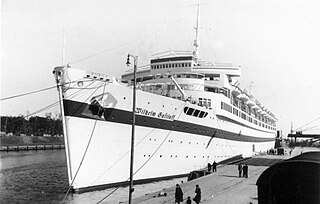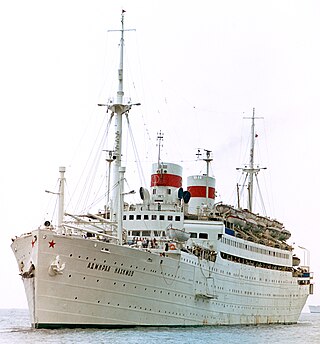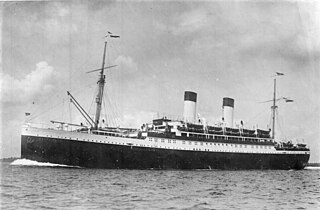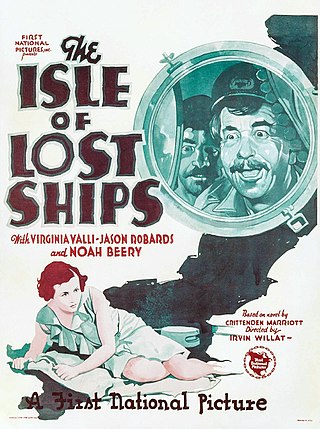
MV Wilhelm Gustloff was a German military transport ship which was sunk on 30 January 1945 by Soviet submarine S-13 in the Baltic Sea while evacuating civilians and military personnel from East Prussia and the German-occupied Baltic states, and German military personnel from Gotenhafen (Gdynia), as the Red Army advanced. By one estimate, 9,400 people died, making it the largest loss of life in a single ship sinking in history.

SS Andrea Doria was a luxury transatlantic ocean liner of the Italian Line, put into service in 1953. She is widely known from the extensive media coverage of her sinking in 1956, which included the remarkably successful rescue of 1,660 of her 1,706 passengers and crew.
The Manila galleon refers to the Spanish trading ships that linked the Philippines in the Spanish East Indies to Mexico, across the Pacific Ocean. The ships made one or two round-trip voyages per year between the ports of Manila and Acapulco from the late 16th to early 19th century. The term "Manila galleon" can also refer to the trade route itself between Manila and Acapulco that was operational from 1565 to 1815.

The Sargasso Sea is a region of the Atlantic Ocean bounded by four currents forming an ocean gyre. Unlike all other regions called seas, it has no land boundaries. It is distinguished from other parts of the Atlantic Ocean by its characteristic brown Sargassum seaweed and often calm blue water.

Captain Horatio Hornblower is a 1951 British naval swashbuckling war film in Technicolor from Warner Bros., produced by Gerry Mitchell, directed by Raoul Walsh, that stars Gregory Peck, Virginia Mayo, Robert Beatty and Terence Morgan.

A boat or ship engaged in the tramp trade is one which does not have a fixed schedule, itinerary nor published ports of call, and trades on the spot market as opposed to freight liners. A steamship engaged in the tramp trade is sometimes called a tramp steamer; similar terms, such as tramp freighter and tramper, are also used. Chartering is done chiefly on London, New York, and Singapore shipbroking exchanges. The Baltic Exchange serves as a type of stock market index for the trade.

SS Admiral Nakhimov, launched in March 1925 and originally named SS Berlin, was a passenger liner of the German Weimar Republic later converted to a hospital ship, then a Soviet passenger ship. On 31 August 1986, Admiral Nakhimov collided with the large bulk carrier Pyotr Vasev in the Tsemes Bay, near the port of Novorossiysk, Russian SFSR, and quickly sank. In total, 423 of the 1,234 people on board died.

The Last Voyage is a 1960 Metrocolor American disaster film starring Robert Stack, Dorothy Malone, George Sanders, and Edmond O'Brien.

The Boats of the "Glen Carrig" is a horror novel by English writer William Hope Hodgson, first published in 1907. Its importance was recognised in its later revival in paperback by Ballantine Books as the twenty-fifth volume of the celebrated Ballantine Adult Fantasy series in February 1971.

Michael Henry Carreras was a British film producer and director. He was known for his association with Hammer Films, being the son of founder James Carreras, and taking an executive role in the company during its most successful years.

The Sea Wolf is a 1941 American adventure drama film adaptation of Jack London's 1904 novel The Sea-Wolf with Edward G. Robinson, Ida Lupino, John Garfield, and Alexander Knox making his debut in an American film. The film was written by Robert Rossen and directed by Michael Curtiz.

RMS Titanic sank on 15 April 1912 in the North Atlantic Ocean. The largest ocean liner in service at the time, Titanic was four days into her maiden voyage from Southampton to New York City, with an estimated 2,224 people on board when she struck an iceberg at 23:40 on 14 April. Her sinking two hours and forty minutes later at 02:20 ship's time on 15 April resulted in the deaths of more than 1,500 people, making it one of the deadliest peacetime maritime disasters in history.
In the Sargasso Sea is a novel written in 1898 by Thomas Allibone Janvier. Recently, Kessinger Publishing's rare reprints has re-issued the book.

The SSCity of Boston was a British iron-hulled single-screw passenger steamship of the Inman Line which disappeared in the North Atlantic Ocean en route from Halifax, Nova Scotia, to Liverpool in January 1870.

MV Monte Cervantes was a 500 ft (150 m) German passenger liner that sailed the South American route from Buenos Aires to Puerto Madryn (Chubut) to Punta Arenas to Ushuaia and return to Buenos Aires. The ship sailed under German registration and belonged to the South American Hamburg Company. After only two years of service she sank at the beginning of 1930 near Tierra del Fuego. The ship became known as "The Titanic of the South."

Final Voyage is an action film released in 1999. The film stars Dylan Walsh, Ice-T, Erika Eleniak, and Claudia Christian. The film revolves around a terrorist attack on a cruise ship.

(For the 1929 talkie see The Isle of Lost Ships )
SS Catterthun was a nineteenth-century cargo and passenger ship. It sank with considerable loss of life on the east coast of Australia in 1895.

The RMS Lusitania was a British-registered ocean liner that was torpedoed by an Imperial German Navy U-boat during the First World War on 7 May 1915, about 11 nautical miles off the Old Head of Kinsale, Ireland. The attack took place in the declared maritime war-zone around the UK, three months after unrestricted submarine warfare against the ships of the United Kingdom had been announced by Germany following the Allied powers' implementation of a naval blockade against it and the other Central Powers.

The Isle of Lost Ships is an all-talking 1929 sound film. The picture was produced by Richard A. Rowland and distributed by Warner Bros. Irvin Willat was the director with Jason Robards Sr., Virginia Valli and Noah Beery Sr. in the leads. It is based on the 1909 novel The Isle of Dead Ships by Crittenden Marriott, and is also a remake of Maurice Tourneur's now lost 1923 classic of the same name. A mute copy of this film is preserved at the Library of Congress. The Vitaphone discs which contain the soundtrack to the film are currently lost. An almost complete copy of the sound version of the film survives at the Eye Filmmuseum archive with an estimated running time of 55:58.

















